Vitamix vs. Blendtec is a popular challenge since either can be a great choice for operation, depending on your specific needs and preferences. Both companies are the industry’s leading professional-grade blender brands and are highly preferred in commercial kitchens or food service operations for their power, durability, practicality, and efficiency. Therefore, in this article, we compared the two for you to make the best choice.
1. Quality
Both the Vitamix and Blendtec blenders are made of commercial-grade, heavy-duty components. Both companies’ products have a larger motor than most other commercial blenders, making them incomparable. They have sturdy stainless steel gears, making them durable for a long time, unlike the plastic gears of low-cost blenders.
Blendtec blenders have thick, blunt-edged blades with wingtips to prevent tampering while blending. Blendtec’s jars are extremely durable, withstanding a drop from two floors without cracking.
The Ascent series of Vitamix blenders feature a jar that is renewed to be more efficient and convenient. With the new self-detect wireless technology integrated into the jars, the blender base communicates with the jar to recognize its size and adjust the level of power and maximum blending time to prevent damaging the jar. Vitamix blender blades are blunt, 4-pronged, and feature pointed tips. A tamper tool pushes the thicker blends back to the blades for consistent results.
2. Design
There are various models of both Blendtec and Vitamix blenders. We choose one of the most popular products from each brand to compare their designs: the Vitamix 5200 vs. Blendtec 575. The most noticeable difference between the blenders is the design of their blades. While Vitamix uses a hammermill and laser-cut blades made of stainless steel, and Blendtec features a blunt blade. The Vitamix’s blades require extra attention to not cut yourself; conversely, Blendtec 575’s blades do a kind of mashing instead of slicing.
Another important difference between Blendtec 575 and Vitamix 5200 is the design of their jars. Vitamix 5200 has a tall glass jar and an opening for an additional tamp. The Blendtec 575 comes with two types of jars, both of which are plastic. The first one, the Fourside jar, has a squared shape which the name suggests and is intended to create more friction, which works better for making hot soup. The other jar, Wildside, has a larger base and a fifth side to make a blending vortex to blend efficiently, removing the need for a tamp, which Blendtec blenders do not have.
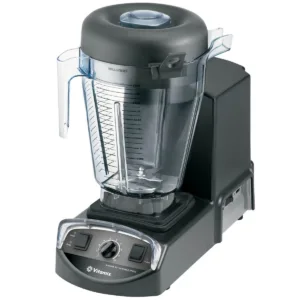
3. Performance
What affects the performance of both blenders is their designs. For example, Vitamix is known for its effectiveness. It smoothly blends most hard products without any clumps with the help of a tamper tool. The rich number of adjustable speeds makes it easy to customize the blends. Blendtec blenders do not feature a tamper tool, but their jars are designed to prevent clumping, eliminating the need for scraping the sides while blending.
4. Accessories
Accessories make blenders more customizable and convenient. Here are several jars and accessories for both blenders:
To-go Smoothie Jar: Both Blendtec and Vitamix have a single-serve smoothie jar for using on-the-go blends. They provide an easy and mess-free blending for taking with you whenever you want and without a need to transfer between containers.
Frothing Jar: Both companies have a frothing jar with a special blade in a round shape to make various sauces, especially cold milk foam.
Food Processor: With Vitamix’s 12-cup food processor attachment, you can have two equipment features in one, saving you money and space in the kitchen. You can use your blender as a food processor to chop, slice, and shred any food easily and perfectly with the powerful motor of the Vitamix blender.

Metal Container: Vitamix offers a stainless steel jar for the blender, ideal for hot soups to blend straight from the pot. Vitamix metal container is non-reactive, long-lasting, and odor free, making it safe and convenient for heavy-duty use.
Twister Jar: Blendtec Twister jar is specially designed to blend tough food items, such as nuts, to make dip sauces or bread dough. The scrapers on the walls of the blender jar can twist scrapes and push down thick products off the walls while blending, providing consistent and smooth outcomes.
Pros and Cons: Vitamix vs. Blendtec
Both blender giants have advantages and disadvantages; thus, you can decide on your specific commercial kitchen needs.
Pros of Vitamix Blenders
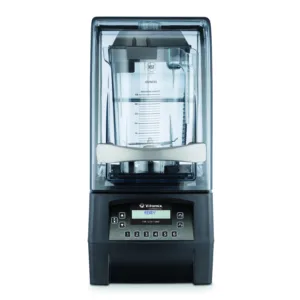
The tampers Vitamix blenders feature is one of the reasons it is mostly preferred. The one drawback of the poor blenders is to stir and scrape the unblended products from the walls and repeat them multiple times to get a smooth blend. This is where tampers step in. The tampers eliminate the need to scrape the products down in the middle of the blending, providing evenly and smoothly blended products. It additionally breaks up the air pockets that dense products create, keeping the mixture within reach of the blades for a faster blending process.
The hole in the lid of the blender allows using the tamper tool while the blender is running. Additionally, the shape of the Vitamix blender is specifically designed to create a vortex, which pushes the products down to the blades to create a smooth blend. The secure lid of the Vitamix blender ensures blending without any splatter.
The curved shape of the jars, the design of the blades, and the motor power of Vitamix blenders make them exceptional in blending, emulsifying, chopping, slicing, and mashing numerous products of different textures. One of the multiple tasks a commercial blender should be able to do is liquifying, and Vitamix blenders do it well. Make a salad dressing with a cheaper blender; you will see the difference. A Vitamix blender can break apart even oil, combining it with other ingredients to create an even mix.
Cons of Vitamix Blenders
The multiple speed and time controls may be a drawback for some people who opt for one button instead of automation.
The average price range of Vitamix blenders makes them suitable for professional and commercial use but can be thought of as a little bit high compared to counterparts, as seen in the cheapest model, which is $350, which is also high for residential kitchens.
Pros of Blendtec Blenders

Automation can be convenient and practical for most, providing easy operation and saving time. The pre-set programs of Blendtec blenders make blending new recipes very simple. It also will give you extra time by removing the need for standing and watching the product blend with the automatic timers.
The powerful motor of Blendtec blenders, typically 3 HP, ensures the blades never slow down, even blending the thickest products. The design of the spout makes pouring any products easy. Additionally, Blendtec is more lightweight than Vitamix blenders.
Cons of Blendtec Blenders
The biggest reason for not preferring a Blendtec blender is the lack of the tamper tool. It will eventually require scraping the product off the walls, slowing down the process. The Twister jar Blendtec offers as an accessory can be an alternative to a tamper tool.
Lastly, because of the more horsepower Blendtec blenders have, they are a little louder than Vitamix blenders.
Final Say for Vitamix vs. Blendtec
In conclusion, Vitamix and Blendtec blenders are both high-quality equipments that are powerful, long-lasting, and versatile, making them a popular choice among professionals. The choice between the two is largely based on personal preference in terms of design, features, and price. Before making a decision, it is a good idea to read reviews, compare features and costs, and even try out the blenders in person if possible.

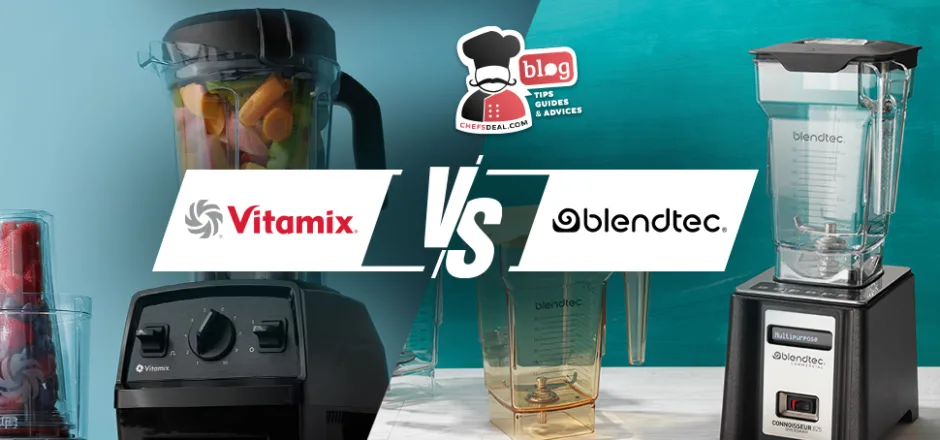


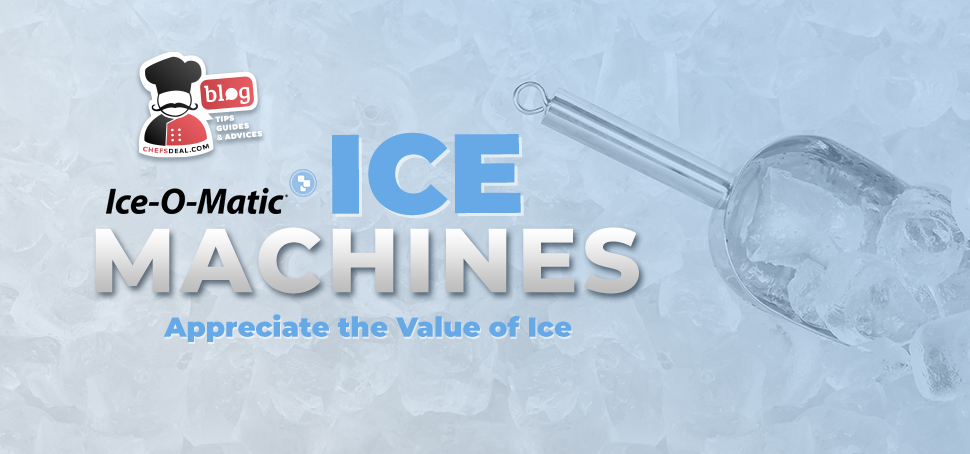
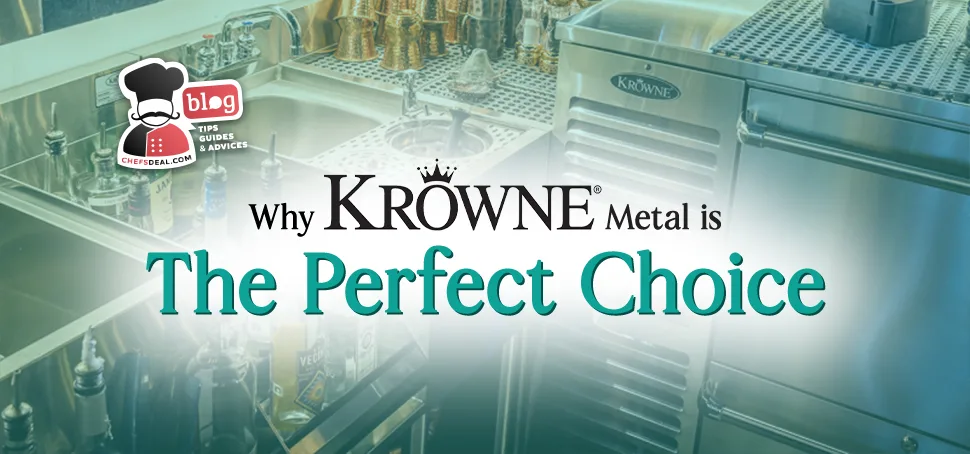

2 comments On Vitamix vs. Blendtec
Vitamix 6300 vs Blendtec Designer 725
Hi Emma,
Thanks for your contribution. We can think about planning another blog that compares these 2 products specifically.